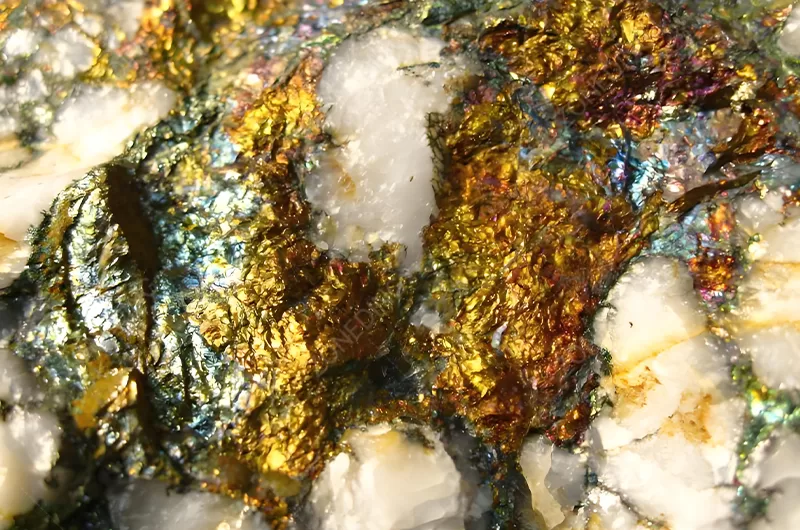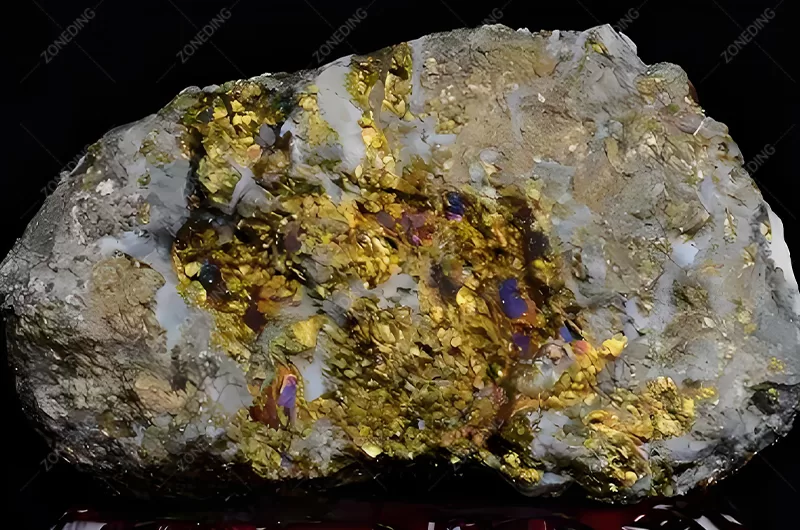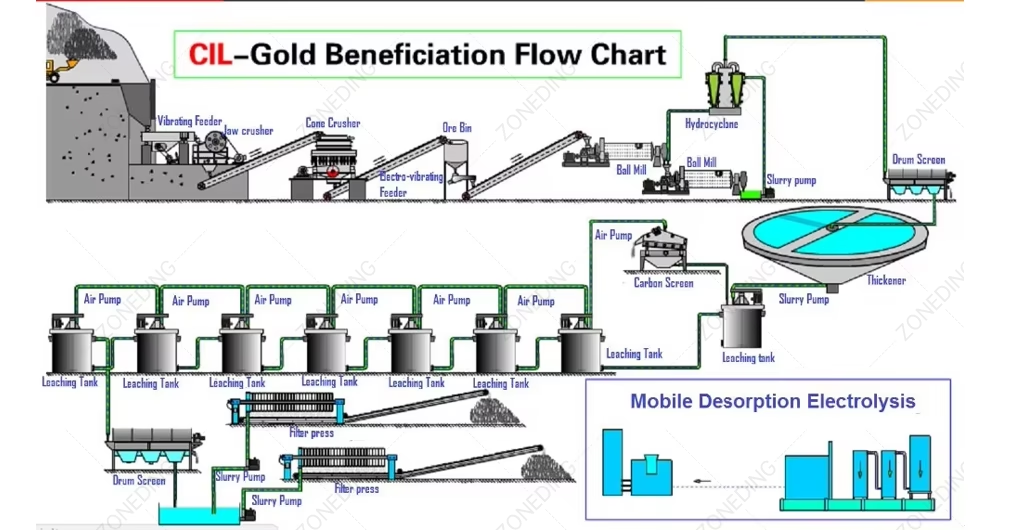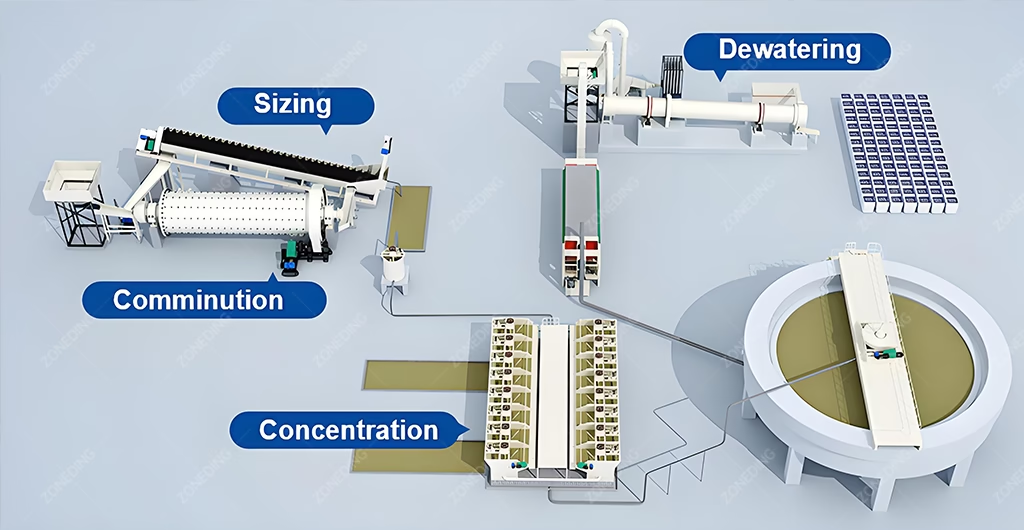全站搜索
Search the entire website
Search the entire website
Gold extraction is the industrial process of separating pure gold from the rock, or ore, that holds it captive.
At my company, ZONEDING, we have been building the specialized machinery for this complex process since our founding in 1990. You must first crush massive amounts of rock to access the tiny, often microscopic, particles of gold locked inside. Then, you use a specific scientific method to persuade that gold to separate from the worthless rock. This is the essence of metallurgical science, how the modern mining industry transforms rugged stone into a valuable, pure metal.
Gold ore is any rock that contains a high enough concentration of gold to make its extraction economically viable.
The gold itself is often completely invisible to the naked eye. You could be holding a piece of high-grade gold ore and not see a single speck of yellow. Its value is determined by the “grade,” a precise measurement of how much gold exists per ton of rock.
For a massive open-pit mine, a grade as low as 0.5 g/t might be profitable because they process millions of tons.
For a smaller underground mine, grades of 5 g/t or higher are typically needed to cover the higher operational costs. Before any major investment, mining companies perform extensive drilling and send rock samples for “assaying,” a chemical analysis that determines the exact gold content. This data is the single most important factor in deciding whether to build a mine.


Most of the world’s primary gold ore deposits are formed by a geological process involving extremely hot, mineral-rich water circulating deep within the Earth’s crust. This is known as a hydrothermal process. This superheated fluid acts as a solvent, picking up dissolved minerals, including gold, as it forces its way through cracks and fissures in the rock.
As this fluid travels towards the surface, it begins to cool, or the pressure drops dramatically. When this happens, it can no longer hold all its dissolved minerals. They begin to crystallize and deposit themselves on the walls of the fissures, often forming the quartz veins that miners treasure. Different temperature and depth conditions create different types of deposits, such as epithermal (formed close to the surface) or mesothermal (formed deeper down). Over millions of years, geological uplift and erosion push these ancient rock formations closer to the surface, where we can finally access them.
You can find gold ore on every continent, but it tends to be concentrated in specific geological environments. The two main categories of deposits dictate the entire approach to mining:


Separating gold is a significant technical challenge for two main reasons. First, gold is one of the most chemically inert or “noble” metals. It strongly resists reacting with other elements, which is why it never rusts or tarnishes. This makes it perfect for jewelry and critical electronics, but it also means we can’t use simple, cheap chemical reactions to coax it out of the rock. We have to use very specific and carefully controlled processes.
Second, gold exists in extremely low concentrations, even in high-grade ore. Imagine grinding up a car and then trying to find a single grain of salt within the pile of metal dust—that’s the scale of the challenge. You must process an enormous volume of waste material to recover a tiny amount of valuable product. The process remains critically important, however, because gold’s immense and stable economic value justifies the massive investment in technology and energy required for its extraction.
Yes, absolutely. Small-scale gold mining can be a very profitable venture, provided you approach it as a serious business. Success hinges on two critical factors: the quality of your gold ore (the grade) and the efficiency of your processing equipment. A small, well-run operation with high-grade ore can easily be more profitable than a massive mining corporation struggling with a low-grade deposit.
The financial key is balancing your initial investment (CAPEX) with your ongoing operational costs (OPEX). Your biggest expenses will be fuel, labor, and equipment maintenance. This is where choosing the right technology from the start is paramount. At ZONEDING, we specialize in providing complete, modular small scale gold mining equipment that is designed for high recovery rates and low energy consumption, helping you maximize your return on investment.
Understanding your specific ore type is essential because it dictates your entire extraction strategy. You simply cannot use the wrong process and expect good results. The main categories are:
Once the ore is crushed to the consistency of sand or fine powder, you must choose a method to separate the gold. Here are the four primary techniques used in the industry today. At ZONEDING, we manufacture the key equipment for all of them.



Choosing the correct method is the single most important technical decision you will make. It absolutely must be based on a professional metallurgical test of your specific ore.
No extraction process is 100% efficient; some gold is always lost to the waste stream, known as “tailings.” The recovery rate is a key performance indicator for any mine. A modern, well-run cyanide leaching plant can achieve recovery rates of 95% or higher. A simple gravity circuit might recover 60-80% of the gold in a suitable free-milling ore. The goal of a well-designed processing plant, like the complete solutions we engineer at ZONEDING, is to maximize this recovery rate. Even a 1% improvement in recovery can translate into millions of dollars in additional revenue for a large mining operation.
The environmental impact of gold mining is a significant global concern that requires rigorous engineering and management.
The doré bars produced at the mine site are not pure gold. They are an alloy containing gold, silver, and other trace metals. These bars are securely transported to a specialized, high-security refinery. There, advanced processes like the Miller Process (using chlorine gas to remove impurities) or the Wohlwill Process (using electrolysis) are employed to separate the metals. This final refining step is what produces the investment-grade gold bars that are 99.9% or even 99.99% pure.
Unquestionably, gravity separation is the safest and most sustainable gold extraction method. It operates purely on the physical principle of density, using only water and mechanical motion. It completely avoids the use of hazardous chemicals like cyanide or mercury, which eliminates the primary source of environmental risk in gold processing. However, its major limitation is that it only works effectively on free-milling ores where the gold particles are coarse enough to be liberated. It cannot recover microscopic gold. Therefore, the most sustainable overall strategy is often an integrated one: use gravity separation as the first step to recover as much gold as possible, thereby reducing the volume of material that requires more energy and chemical-intensive treatment later.
Gabbro is an incredibly tough and durable rock. It makes some of the best construction aggregate in the world. However, its toughness also makes it a challenge to process. My company, ZONEDING, has been designing and building crushing plants sinc...
View detailsChoosing the right rock crusher is a major decision for your quarry or mining operation. The wrong choice can lead to wasted money, inefficient production, and lower profits. Jaw crushers and impact crushers are two of the most common types of cr...
View detailsYour cone crusher is the engine of your secondary and tertiary crushing operations. When it's running smoothly, it's a non-stop profit center, turning oversized rock into valuable, specified products. But when it goes down, your entire production...
View detailsYou interact with copper every single day, often without realizing it. It is in the electrical wiring in your walls, the plumbing pipes that bring you water, and the smartphone in your pocket. My company, ZONEDING, has built the heavy machinery f...
View details